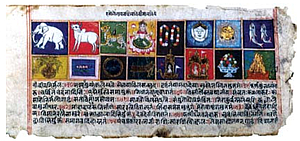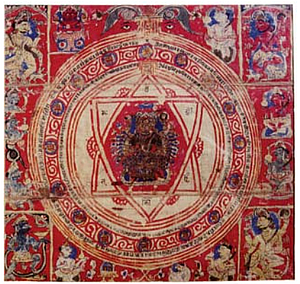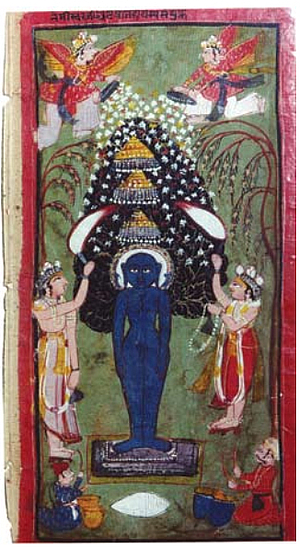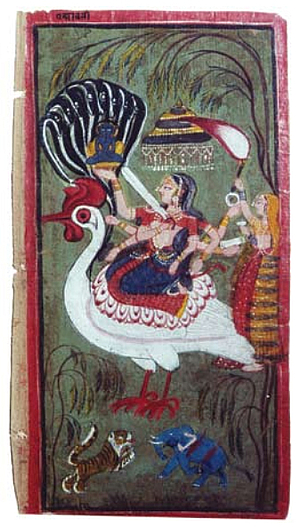
Centre of Jaina Studies Newsletter: SOAS - University of London
The collection of Indian painting at the University of California Berkeley Art Museum and Pacific Film Archive is quite rich in the number and diversity of its Jaina holdings. The great majority were gifts of the late Jean and Francis Marshall, who gave more than 300 paintings to the Museum. Francis, in particular, was very fond of early painting, especially works in the Western Indian style, the majority of which are Jaina. The collection contains quite a few folios from typical Śvetāmbara Kalpasūtra, Kālakācāryakathā, and Saṃgrahaṇīsūtra manuscripts, including a complete illustrated text of the last work. However, of particular interest are folios from other Jaina manuscripts, especially two seventeenth-century examples from a Digambara text, labelled on the folios as a Nemipurāṇa. 1 (Figure 1)
An interesting example from this text is an illustrated folio that depicts the Sixteen Lucky Dreams of Nemi's mother, Queen Śivā. We are familiar with depictions of the Śvetāmbara Fourteen Dreams in hundreds of Kalpasūtras known in temple libraries, museums, and private collections,2 but Digambara texts are far more rare. This Digambara manuscript follows a later Rajasthani style with a varied palette consisting of multiple shades of colours and a softer, less angular delineation of the figures. Each dream is depicted with a bold element against bright contrasting backgrounds.
The style of these paintings can be contrasted with the more numerous Śvetāmbara paintings characterized by Figures 2 and 5. Figure 2 illustrates the familiar angular figure of the Western Indian style, but here too the palette is somewhat wider than usually seen in other paintings dating from the fifteenth century, typified by Figure 5.
Figure 2 is especially interesting because it is the opening folio of the Anuyogadvārasūtra, a post-canonical text. One often gets the impression that among Śvetāmbara manuscripts only the Kalpasūtra, Kālakācāryakathā, and Saṃgrahaṇīsūtra were illustrated, but there is ample evidence that many other texts were illustrated as well, although not in such numbers and usually including only a few paintings. The usual style is confined to black lines and gold with touches of green and blue against either a red, or later a blue background, but the decoration of this folio represents a deluxe version of the Western Indian style. The text is written in gold against a red background and the edges are elaborately patterned. The composition depicts either a Jina or an icon of a Jina placed on a storied platform reminiscent of the levels of a samavasaraṇa or model of Mount Meru, with the central figure surrounded by monks, nuns, and lay attendants.

Figure 1. Sixteen lucky dreams of Queen Śivā Folio 36r from a dispersed Nemipurāṇa manuscript Rajasthan, Marwar (Jodhpur?), 17th century Ink, opaque watercolour, and gold on paper Gift of Jean and Francis Marshall University of California, Berkeley Art Museum and Pacific Film Archive 1998.42.104.1

Figure 2. Adoration of a Jina Folio 1v of a dispersed Anuyogadvārasūtra manuscript Western Indian Style, Gujarat or Rajasthan, early 15th century Ink, opaque watercolour, and gold on paper Gift of Jean and Francis Marshall University of California, Berkeley Art Museum and Pacific Film Archive 1998.42.42

Figure 3. Universe depicted in the shape of a human Folio 27r from a dispersed Saṃgrahaṇīsūtra manuscript Rajasthan, Sirohi, late 16th century Ink and opaque watercolour on paper Gift of Jean and Francis Marshall University of California, Berkeley Art Museum and Pacific Film Archive 1998.42.99.2

Figure 4. Birth of an asurakumāra (detail) Folio 26r from a dispersed Saṃgrahaṇīsūtra manuscript Rajasthan, Sirohi, late 16th century Ink and opaque watercolour on paper Gift of Jean and Francis Marshall University of California, Berkeley Art Museum and Pacific Film Archive 1998.42.99.1

Figure 5. Yantra of Pañcāṅgulī Western Indian style, Gujarat or Rajasthan, ca. 1425 Ink, opaque watercolour, and gold on cloth Gift of Jean and Francis Marshall University of California, Berkeley Art Museum and Pacific Film Archive 1999.15.24

Figure 6. The Jina Nemi Rajasthan, Bundi sub-style, 17th century Ink and opaque watercolour on paper Gift of Jean and Francis Marshall University of California, Berkeley Art Museum and Pacific Film Archive 1998.42.2.1

Figure 7. Padmāvatī Rajasthan, Bundi sub-style, 17th century Ink and opaque watercolour on paper Gift of Jean and Francis Marshall University of California, Berkeley Art Museum and Pacific Film Archive 1998.42.2.2
Where the intent of this Anuyogadvārasūtra painting is devotional, other Jaina paintings concern the elaborate cosmography developed by Jainism. Figure 3 represents a depiction of the Jaina universe in the shape of a human being. It comes from what is usually called a Saṃgrahaṇīsūtra (that is, in this case probably the Saṃgrahaṇīratna or Saṃghayaṇarayaṇa in Prakrit). Here two different ways of describing the universe are combined. One is the human figure itself with the levels of hell forming its lower body, the world of men -here only the central Jambūdvīpa portion at its waist-, and the heavens above. A second diagram of the universe consists of numbers and here they are added to the sides of each level corresponding to various measurements. This type of image is often misleadingly labelled as lokapuruṣa, implying that the universe is thought of as a Cosmic Man rather than just in the shape of a person standing with arms akimbo. As is probably the case here, some of these paintings clearly depict women as well. A human figure in this pose is logically suggested by the shape of the Jaina universe, the loka-ākāśa, as described in texts.
A second folio from the same manuscript in the UC Berkeley collection illustrates a scene from the upper level of the underworlds, the birth of an asurakumāra. (Figure 4) These demi-gods dwell in jewel-encrusted palaces and, like other celestial and infernal beings, manifest themselves, becoming fully developed, in only 48 minutes. A clever element here is the depiction of the demigod's face in a mirror held by the woman at his feet.
Another rare and interesting painting in the collection is an early Western Indian style cloth painting, a yantra of Pañcāṅgulī. (Figure 5) She is a goddess who can be associated with the Hindu goddess Kālī. The figures in the corners of this yantra relate directly to figures of Śiva; names of him and his consort are found in the mantras that encircle some of the elements of the painting. The figures around the two concentric circles and between these corner figures depict the navagraha - the sun and moon at the top with the other seven 'planets' curving around the composition.
Two last paintings deserve our attention. They are from what appears to have been a bound book in vertical format of various Digambara Jaina paintings. Figure 6 depicts Nemi being adored and endowed with the eight auspicious insignia of Jinahood. The label reads: nemisvarajī aṣṭaprātihāryaspasaṃyukta. These insignia include vidyādharas, looking like western angels, pouring flowers over the nude Nemi and attendants holding cauris or yak-tail flywhisks, signs of royalty and respect. At his feet are drummers creating a celestial sound and a conch shell that is not only the lāñchana or insignia of Nemi, but also can be associated with a celestial sound, since a conch is often blown during rituals. He is backed by an auspicious tree, has a solar disk behind his head, and stands on a throne. Three parasols surmount the composition.
The other painting from this disbound book is an image of Padmāvatī riding her vehicle, in this case a kukkuṭasarpa, a snake in the shape of a rooster. (Figure 7) She holds aloft an image of Pārśva on a throne, surmounted by a snake-hood. At her mount's feet a tiger and elephant, natural enemies, come to worship the Jina in peace. These few examples from the University of California Berkeley Art Museum and Pacific Film Archive represent a small percentage of their holdings of Jaina painting, but give an idea of the richness of Jaina art in the collection. Few larger collections of Indian painting, both private and public, include this wide a variety of Jaina works. Other collections in the San Francisco Bay Area also include some interesting Jaina material, which could complement and enrich a possible collective exhibition with other facets of Śvetāmbara and Digambara art.
All images are © University of California, Berkeley Art Museum and Pacific Film Archive
Robert J. Del Bontà has lectured and published on a wide variety of subjects including Jaina art from all over India. He has curated many exhibits at the Asian Art Museum of San Francisco and most recently was a major contributor to The Victorious Ones: Jain Images of Perfection at the Rubin Museum of Art.
 Dr. Robert J. Del Bonta
Dr. Robert J. Del Bonta